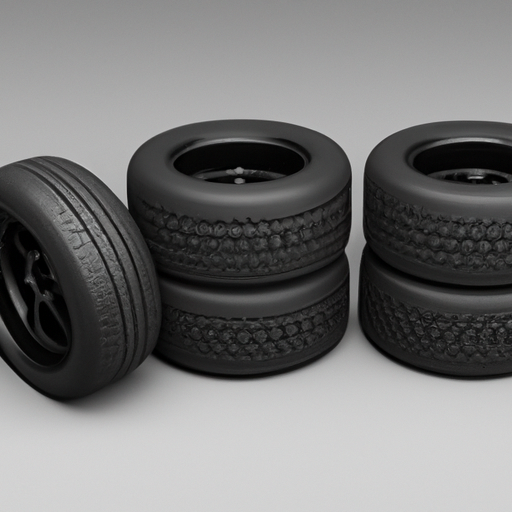Imagine a world where driving without wheel weights was not only possible but also safe. We all know that wheel weights play a crucial role in balancing tires and ensuring a smooth ride. But what if there was an innovative solution that eliminated the need for these seemingly small metal discs? In this article, we will explore the fascinating concept of driving without wheel weights and examine whether it is a viable option for motorists.

The Importance of Wheel Weights
What are wheel weights?
Wheel weights are small metal or lead weights that are strategically attached to the rim of a vehicle’s wheels. These weights are specifically designed to balance the tire and wheel assembly and ensure a smooth and stable ride. They come in various shapes and sizes and are typically installed by professionals during the tire mounting or balancing process.
The purpose of wheel weights
The primary purpose of wheel weights is to correct any imbalance that may occur in the tire and wheel assembly. When a tire is mounted on a wheel, there is a possibility that it may not be perfectly balanced. This imbalance can result from variations in tire construction, manufacturing tolerances, or even the valve stem. Wheel weights are used to counterbalance these imperfections by adding or removing weight as needed.
Effect of unbalanced wheels
Unbalanced wheels can have a significant impact on the overall performance and safety of your vehicle. When your wheels are not properly balanced, it can lead to several issues such as vibrations, uneven tire wear, and potential damage to suspension components. These problems can also affect your vehicle’s fuel efficiency, handling, and overall ride comfort.
Safety concerns
Driving with unbalanced wheels can be unsafe, especially at high speeds. The vibrations caused by the imbalance can affect the steering and handling of your vehicle, making it more difficult to control. This can increase the risk of accidents, especially during sudden maneuvers or emergency stops. Additionally, unbalanced wheels can put unnecessary stress on various components of your vehicle’s suspension system, potentially leading to premature wear and increasing the likelihood of mechanical failures.
What Happens If Wheel Weights are Missing?
Symptoms of unbalanced wheels
If your wheel weights are missing, you may experience noticeable symptoms that indicate an imbalance in your tire and wheel assembly. One of the most common signs is vibrations, which can be felt through the steering wheel or the entire vehicle. These vibrations tend to become more pronounced as you increase your speed. Another symptom of unbalanced wheels is uneven tire wear. You may notice excessive wear on one side of the tire, indicating that weight distribution is uneven due to the absence of wheel weights.
Impact on vehicle performance
The absence of wheel weights can significantly impact your vehicle’s performance. Unbalanced wheels can cause your vehicle to feel unstable and less responsive, making it difficult to maintain control on the road. This can be particularly concerning during cornering or braking, as the imbalance can affect the grip and traction of your tires. Additionally, the vibrations caused by unbalanced wheels can lead to driver fatigue, as prolonged exposure to the shaking motion can be both uncomfortable and distracting.
Tire wear and tear
Missing wheel weights can cause uneven tire wear, which can affect the lifespan and performance of your tires. When a tire and wheel assembly is unbalanced, it places uneven pressure on the tread. This can result in accelerated wear on one side of the tire, leading to a shorter tire lifespan and the need for premature replacements. Uneven tire wear can also affect the overall handling and performance of your vehicle, compromising your safety on the road.
Steering and handling issues
The absence of wheel weights can have a significant impact on your vehicle’s steering and handling. Unbalanced wheels can cause your steering to feel unstable, making it harder to maintain a straight line or maneuver safely. This can be particularly problematic during emergency situations, where precise control of your vehicle is crucial. Additionally, unbalanced wheels can put unnecessary strain on the suspension system, potentially leading to premature wear and compromising the overall performance and longevity of your vehicle.
Can You Drive Without Wheel Weights?
Potential risks of driving without wheel weights
While it is technically possible to drive without wheel weights, it is not recommended due to the risks involved. The absence of wheel weights can lead to excessive vibrations, compromised vehicle performance, and increased wear and tear on tires and suspension components. These factors can not only impact your overall driving experience but also compromise your safety on the road.
Temporary solutions
If you find yourself in a situation where your wheel weights are missing, there are a few temporary solutions that can help minimize the impact of unbalanced wheels. One option is to have your vehicle’s tires and wheels rebalanced as soon as possible. This will involve adding new wheel weights in the correct locations to counterbalance the assembly. Another temporary solution is to reduce your driving speed and avoid high-speed or aggressive maneuvers until the issue can be addressed.
Long-term effects
Driving for an extended period without wheel weights can have long-term effects on your vehicle’s performance and safety. The vibrations caused by unbalanced wheels can lead to premature wear on suspension components, potentially requiring costly repairs or replacements. Additionally, the uneven tire wear resulting from unbalanced wheels can reduce the lifespan of your tires and impact their overall performance. It is important to address the issue promptly to avoid any further damage or safety risks.
Alternative Ways to Balance Wheels
Dynamic wheel balancing
Dynamic wheel balancing is an alternative method used to balance wheels that provides a more accurate balancing solution compared to traditional static balancing. Dynamic balancing involves placing the wheel and tire assembly on a specially designed machine that rotates it at high speed. The machine uses sensors to detect any imbalance and then automatically adds or removes weight from specific areas of the rim. This method ensures a more precise balance and can result in a smoother and more stable ride.
Road force balancing
Road force balancing is another advanced balancing technique that measures the interaction between the wheel and tire under simulated-road conditions. This method involves applying a force onto the tire and wheel assembly while it is spinning. Sensors then measure the tire and wheel assembly’s response to this force, identifying any imbalances and recommending the optimal placement of wheel weights. Road force balancing is particularly effective at identifying and addressing high spot variations in the tire and wheel assembly.
Balancing beads
Balancing beads are small, granulated beads that are placed inside the tire during installation. These beads distribute themselves evenly throughout the tire’s inner surface when the wheel is in motion, automatically adjusting to any imbalances. As the tire rotates, the beads continuously reposition themselves to minimize vibration and ensure a smoother ride. Balancing beads are a popular alternative to traditional wheel weights for off-road or heavy-duty vehicles, as they can provide effective balancing even in rugged and challenging conditions.
Balancing compounds
Balancing compounds are liquid or gel-like substances that are injected into the tire during installation. These compounds are specifically designed to redistribute themselves along the inside of the tire as it rotates, creating a self-adjusting balancing effect. Balancing compounds work by equalizing the tire’s weight distribution and minimizing any imbalances. They are particularly popular for larger tires and can provide effective balancing while also acting as a sealant for minor punctures or leaks.

How to Address the Issue of Missing Wheel Weights
Rebalancing the wheels
The most effective way to address the issue of missing wheel weights is to have your vehicle’s wheels rebalanced by a professional. This will involve removing the tires from the wheels and using a balancing machine to accurately determine the precise weight distribution needed. New wheel weights will then be properly installed, ensuring a balanced tire and wheel assembly. It is important to seek professional help to ensure the balancing process is done correctly and to prevent any further issues.
Consulting a professional
If you are unsure about how to address the issue of missing wheel weights or if you suspect other underlying problems with your tires or wheels, it is best to consult a professional. A qualified technician can inspect your tires and wheels, diagnose any issues, and provide expert advice on the best course of action. They can also ensure that the proper balancing techniques and equipment are used to address the imbalance effectively.
Installing a new set of wheel weights
If your wheel weights are missing or damaged, it may be necessary to install a new set of wheel weights. Wheel weights are relatively inexpensive and widely available, making them an affordable solution to ensure the proper balancing of your tire and wheel assembly. When installing new wheel weights, it is crucial to ensure that they are correctly placed and secured, as improper installation can result in further imbalance issues.
Preventative Measures to Maintain Wheel Balance
Regular tire maintenance
One of the best ways to maintain proper wheel balance is through regular tire maintenance. This includes routine tire inspections, ensuring proper tire inflation, and regularly rotating the tires. By keeping your tires in good condition and properly inflated, you can reduce the likelihood of imbalances occurring. Regular tire rotations also help distribute the wear evenly across all tires, reducing the chances of uneven tire wear and imbalance issues.
Avoidance of road hazards
Avoiding road hazards is another important preventative measure to maintain wheel balance. Potholes, curbs, and other road irregularities can cause damage to your wheels and tires, potentially leading to imbalances. By driving cautiously and being aware of your surroundings, you can minimize the risk of encountering road hazards that can impact the balance of your tire and wheel assembly.
Checking wheel balance during tire rotations
During routine tire rotations, it is important to also check the wheel balance. Even if your vehicle does not exhibit any noticeable symptoms of imbalance, it is still a good practice to periodically verify the balance of your wheels. This can help identify any potential imbalances early on and allow for timely adjustments or corrections to ensure optimal performance and safety.

Common Misconceptions about Wheel Weights
Wheel weights’ impact on tire pressure
One common misconception about wheel weights is that they affect tire pressure. However, wheel weights themselves do not have any direct impact on tire pressure. The wheel weights are designed to counterbalance the tire and wheel assembly, and their purpose is solely to correct imbalances. Proper tire pressure is primarily dependent on factors such as temperature, driving conditions, and the tire manufacturer’s recommendations.
Temporary solutions as a permanent fix
Another misconception is that temporary solutions such as reducing driving speed or adding makeshift weights can serve as a permanent fix for missing wheel weights. While these temporary solutions may reduce the immediate impact of unbalanced wheels, they are not a reliable or long-term solution. It is essential to have your wheels properly balanced by a professional and ensure that the correct wheel weights are installed.
Reliability of alternative balancing methods
Some drivers may question the reliability of alternative balancing methods such as balancing beads or balancing compounds. While these alternatives have been proven effective for certain applications, their reliability can vary depending on factors such as vehicle type, tire size, and driving conditions. It is important to consult with a professional to determine the most suitable balancing method for your specific needs and to ensure that all safety and performance requirements are met.
Conclusion
In conclusion, wheel weights play a crucial role in ensuring the proper balance and performance of your vehicle’s tire and wheel assembly. Unbalanced wheels can have a significant impact on safety, handling, and tire wear. While it is not recommended to drive without wheel weights, there are temporary solutions that can minimize the immediate effects. However, it is important to address the issue promptly and seek professional help to ensure a reliable and long-term solution. Regular tire maintenance, avoidance of road hazards, and periodic wheel balance checks are essential to maintaining wheel balance and maximizing the lifespan of your tires. By understanding the importance of wheel weights and taking preventative measures, you can enjoy a smoother, safer, and more enjoyable driving experience.


